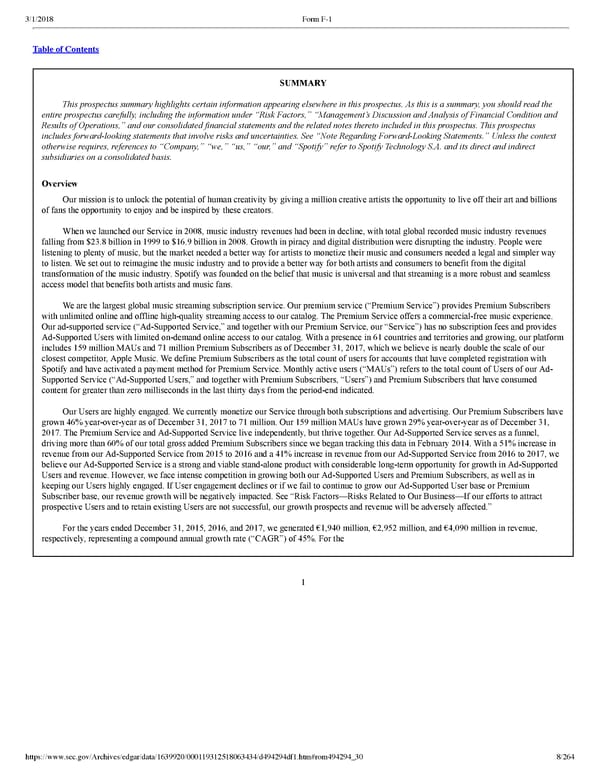8/264 SUMMARY This prospectus summary highlights certain information appearing elsewhere in this prospectus. As this is a summary, you should read the entire prospectus carefully, including the information under “Risk Factors,” “Management’s Discussion and Analysis of Financial Condition and Results of Operations,” and our consolidated financial statements and the related notes thereto included in this prospectus. This prospectus includes forwardlooking statements that involve risks and uncertainties. See “Note Regarding ForwardLooking Statements.” Unless the context otherwise requires, references to “Company,” “we,” “us,” “our,” and “Spotify” refer to Spotify Technology S.A. and its direct and indirect subsidiaries on a consolidated basis. Overview Our mission is to unlock the potential of human creativity by giving a million creative artists the opportunity to live off their art and billions of fans the opportunity to enjoy and be inspired by these creators. When we launched our Service in 2008, music industry revenues had been in decline, with total global recorded music industry revenues falling from $23.8 billion in 1999 to $16.9 billion in 2008. Growth in piracy and digital distribution were disrupting the industry. People were listening to plenty of music, but the market needed a better way for artists to monetize their music and consumers needed a legal and simpler way to listen. We set out to reimagine the music industry and to provide a better way for both artists and consumers to benefit from the digital transformation of the music industry. Spotify was founded on the belief that music is universal and that streaming is a more robust and seamless access model that benefits both artists and music fans. We are the largest global music streaming subscription service. Our premium service (“Premium Service”) provides Premium Subscribers with unlimited online and offline highquality streaming access to our catalog. The Premium Service offers a commercialfree music experience. Our adsupported service (“AdSupported Service,” and together with our Premium Service, our “Service”) has no subscription fees and provides AdSupported Users with limited ondemand online access to our catalog. With a presence in 61 countries and territories and growing, our platform includes 159 million MAUs and 71 million Premium Subscribers as of December 31, 2017, which we believe is nearly double the scale of our closest competitor, Apple Music. We define Premium Subscribers as the total count of users for accounts that have completed registration with Spotify and have activated a payment method for Premium Service. Monthly active users (“MAUs”) refers to the total count of Users of our Ad Supported Service (“AdSupported Users,” and together with Premium Subscribers, “Users”) and Premium Subscribers that have consumed content for greater than zero milliseconds in the last thirty days from the periodend indicated. Our Users are highly engaged. We currently monetize our Service through both subscriptions and advertising. Our Premium Subscribers have grown 46% yearoveryear as of December 31, 2017 to 71 million. Our 159 million MAUs have grown 29% yearoveryear as of December 31, 2017. The Premium Service and AdSupported Service live independently, but thrive together. Our AdSupported Service serves as a funnel, driving more than 60% of our total gross added Premium Subscribers since we began tracking this data in February 2014. With a 51% increase in revenue from our AdSupported Service from 2015 to 2016 and a 41% increase in revenue from our AdSupported Service from 2016 to 2017, we believe our AdSupported Service is a strong and viable standalone product with considerable longterm opportunity for growth in AdSupported Users and revenue. However, we face intense competition in growing both our AdSupported Users and Premium Subscribers, as well as in keeping our Users highly engaged. If User engagement declines or if we fail to continue to grow our AdSupported User base or Premium Subscriber base, our revenue growth will be negatively impacted. See “Risk Factors—Risks Related to Our Business—If our efforts to attract prospective Users and to retain existing Users are not successful, our growth prospects and revenue will be adversely affected.” For the years ended December 31, 2015, 2016, and 2017, we generated €1,940 million, €2,952 million, and €4,090 million in revenue, respectively, representing a compound annual growth rate (“CAGR”) of 45%. For the 1
 Spotify F1 | Interactive Prospectus Page 7 Page 9
Spotify F1 | Interactive Prospectus Page 7 Page 9